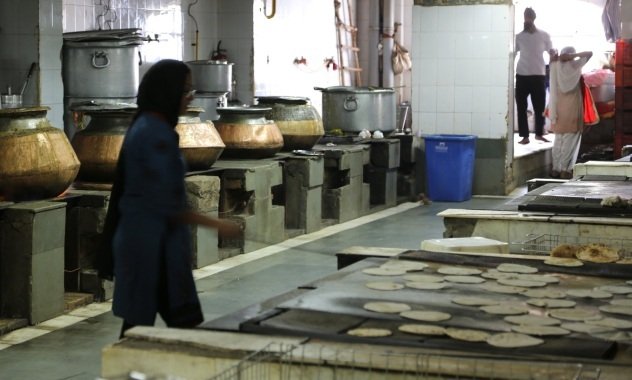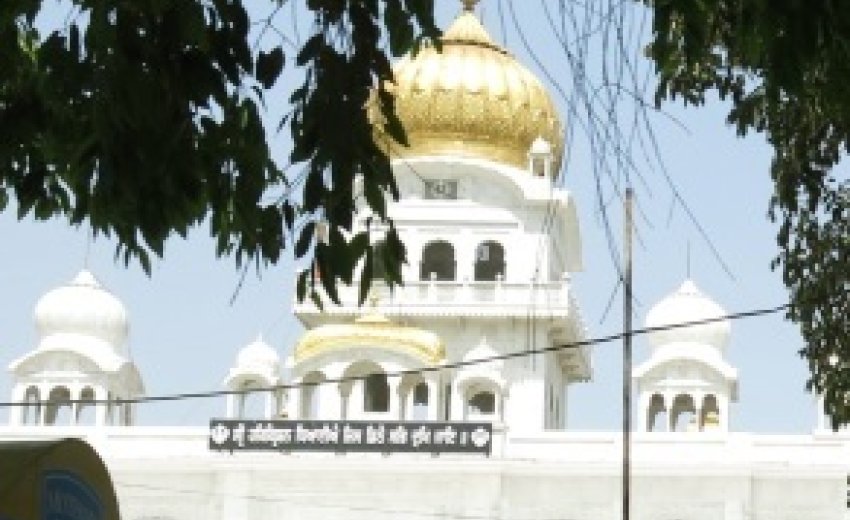 August 22, 2013: Men and women here pray to their own god. "They bring their god with them," the young devotee gently smiles.
August 22, 2013: Men and women here pray to their own god. "They bring their god with them," the young devotee gently smiles.
I am shoeless, head covered, at the Sikh temple in Hanuman Road, Delhi. There are gold panels, a central dais with a book, but no images inside the temple - nothing like statues of the thousands of Hindu gods, no Jesus Christ hanging on the cross, no big Buddha with auspiciously drooping earlobes.
"No. Each man and woman can pray to their own god. Freedom of expression."
This young devotee, who has offered to show me around, smiles. It's a smile he is used to wearing, for Sikhism does not accept the ideology of pessimism, but advocates optimism and hope.
Three musicians fill the temple with rhythm and spiralling sound.
Two are singing, one of them playing a small harmonium, and the third man is playing a tabla drum.
They will make music for an hour, and then the reading of the book will continue.
The Sikh holy book, Guru Granth Sahib, teaches brotherhood.
For the Sikh religion was founded by Guru Nanak, who was born in 1469 and followed by nine other gurus, who added to and developed the belief.
But the 10th and last, Guru Gobind Singh, who died in 1708, ordained that the Guru Granth Sahib - this book -would take over as the ultimate and permanent guru.
And so it is here, in the centre of the temple, and central to these lives.
Sikhs are baptised (and anyone accepting the beliefs and lifestyle can be baptised into Sikhism), do not cut their hair, do not drink alcohol or smoke, are vegetarian, regard another's wife as his sister, another man's daughter as his own daughter, and women as of equal soul to men.
Women do not wear a veil but are expected to dress politely. Marriage is regarded as a holy union, not a contract.
Any person can visit the temple, regardless of creed, culture or nationality and, indeed, my new Sikh companion emphasises, Sikhs do not recognise caste.
"Everyone here is equal. It is a brotherhood," says the young Sikh who is with me now.
Part of me wishes I could tell you his name and show you a photograph of him but the bigger part of me is happy that it seemed inappropriate to ask him for either.
He just appeared, offered advice on removing shoes and head covering and then asked: "Would you like me to show you around my temple? It would be my pleasure."
He emphasises the words "my pleasure". Indeed, he refused the money I later offered him - it was a service and a pleasure for this young man, who had spent his childhood running around the temple.
The visit to the Sikh temple is one of the most interesting and insightful things I do in Delhi - just head into the door that says Information Centre, look confused and slightly lost, and someone is sure to help. Like, in my case, this young Sikh.
As we step into the temple, devotees kiss the ground - "the top of my being is going to the bottom of my being, in utmost respect".
"Do you have time to sit? Perhaps for 10 or 20 minutes?" And we do, listening to the music, letting it spiral inside.
"Some people come and sit, others don't have time," the young Sikh says.
"If you don't have time, it's OK. If you have work to do, go and do your work. It's no use sitting here thinking of horse selling in Bagh. You should go and sell horses in Bagh."
It is a Monday and the place is busy. But then, it is every day.
For one important aspect of Sikhism is food and dining together, and every day perhaps 10,000 to 12,000 people will be fed here by volunteers. The food is free.
 The big kitchen at the Sikh temple in Delhi might feed 10,000 people a day. |
From all walks of life, locals and visitors from all countries, all religions, they sit cross-legged, waiting in an organised queue, until a dining area that can seat up to 800 people in rows on mats on the floor empties, and the next wave is let in. It happens about every 25 minutes.
Stainless-steel trays, with compartments for different foods, are brought to each person.
A man walks the rows dropping a spoon into hands held up together as if in prayer. Then chapati, dhal, vegetables, rice.
In the kitchen behind, pots holding perhaps 100 litres are boiling away over gas cookers, and a chapati machine is turning out the flatbreads like a tennis-ball serving machine, before they are put on big, hot plates and flipped like fish.
It takes two hours for 25kg of lentil dhal to cook.
Food is served for eight hours a day - four hours at lunchtime and four in the evening.
And then, about 9 or 9.30pm every day, the book- Guru Granth Sahib - starts to be gradually moved to another place, where it will spend the night, away from the centre of the temple. As if, as the people sleep, the guru rests, too.
"Inside the temple, men and women pray to their god, listen to their god and to music," the young Sikh says. "Inside, there is only the word. All untouchability is abolished. Everyone is equal."
They are the last words I hear the young Sikh say.
He has shown me back to the entrance, and he is there with me, but when I turn to thank him the room is empty.

